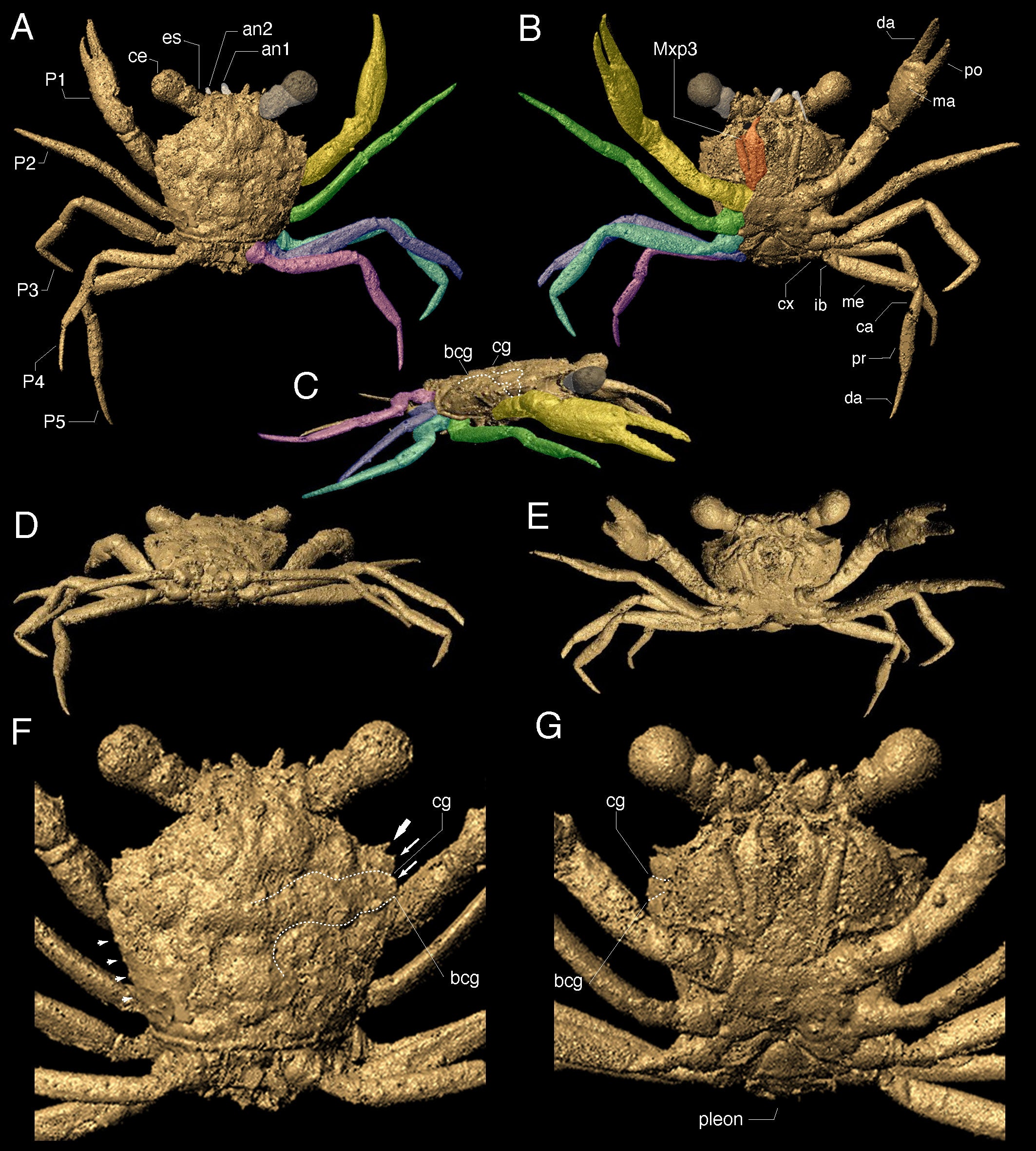A 100-million-year-old crab found beautifully preserved in amber is shedding new light on this iconic group of animals.
New research in Science Advances describes the first known fossil crab from the dinosaur era. That the crab was found preserved in amber is a major win for paleontologists, given the rarity of such things. Plops of tree resin are famous for preserving bugs, microorganisms, plant material, feathers, and the occasional bird. But as for resin trapping crabs and other apparent sea creatures, not so much. Indeed, by getting tangled in tree resin, this crab is telling us something about its behaviour and the environment in which it once lived; a sea creature, this animal was not.
The fossil, found in Myanmar, is quite incredible. Kept at the Longyin Amber Museum in Yunnan, China, the crab’s unique set of characteristics warranted the creation of a new species, Cretapsara athanata, which means “the immortal Cretaceous spirit of clouds and water.” In an email, Javier Luque, the lead author of the study and a postdoctoral researcher in the Department of Organismic and Evolutionary Biology at Harvard University, said the 100 million-year-old specimen “is the most complete fossil crab ever discovered,” as it’s “not missing a single hair, literally!”

Micro CT scans of the fossil allowed the team to visualise the crab’s anatomy in three dimensions, including views of its gills, antennae, large compound eyes, and mouthparts lined with fine hairs. The crab, with its 0.20-inch-long (5-millimetre-long) legs, is quite tiny, and the team can’t decide if it’s a baby, a juvenile, or a full-blown adult.
The crab is smaller than most living or extinct crab species, but its body, claws, and legs are similar to those observed in several modern crabs. At the same time, its slender mouthparts and narrow chest are reminiscent of some ancient crabs. Luque said it’s the “oldest modern-looking crab known to date.”
C. athanata, with no apparent lung tissue and well-developed gills, was likely capable of living on the land. This could explain how the semi-aquatic animal eventually met its fate in a drop of tree resin. During the Cretaceous, trees capable of producing resin were principally evergreens, which means the crab must’ve lived in an evergreen forest (or at least close to one), Luque explained.
“The presence of well-developed gills in Cretapsara athanata, which measures only 5 millimetres, indicate an aquatic to semi-aquatic lifestyle and suggests that it was a juvenile of a larger freshwater to brackish species that lived near a forested fluvio-estuarine [i.e. a drowned river valley] to coastal setting,” he said. “Some freshwater crabs today are also … amphibious, which would also facilitate a mainly aquatic animal to be trapped in tree sap in the forest.”

Another possibility, said Luque, is that C. athanata was a baby crab belonging to a terrestrial species similar to the Christmas Island red crabs. These crabs famously release their babies into the ocean, and they then swarm onto land by the millions. Luque also pointed to modern crabs in the Sesarmidae family, which are tree climbers. If C. athanata was similar, this could likewise explain its connection to tree resin.
Importantly, the fossil is helping scientists to understand the origin of freshwater crabs and to pinpoint the period during which they emerged.
True crabs, known as Brachyura, are crustaceans that emerged around 200 million years ago during the Jurassic. Most crabs, both then and now, are sea creatures, but some adapted to distinctively non-marine habitats, including land, brackish pools, and freshwater.
Molecular evidence suggests the split between marine and non-marine crabs happened around 130 million years ago, while the oldest fossil evidence of non-marine crabs, though very fragmentary in nature, dates back to between 75 million and 50 million years ago. Luque said the new 100-million-year-old fossil crab, found complete and encased in amber, “bridges in a spectacular form the gap between the predicted molecular time of split of nonmarine crabs and the fossil record previously known.”
The new fossil suggests crabs ventured onto dry land at least 25 t0 50 million years earlier than previously assumed. Luque said the amber fossil is pushing the timing and origin of many crab groups further back in time, while also revealing a new branch in the crab family tree.
“Every fossil we discover challenges our preconceptions about the time and place of origin of several organisms, often making us look further back in time and into new geographic areas,” he said.
More: 16-Million-Year-Old Tardigrade Found Preserved in Amber.
